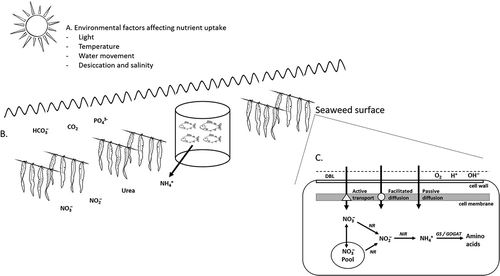Figures & data
Fig. 1. Schematic of (A) environmental factors regulating uptake nutrient by seaweeds; (B) inorganic carbon, phosphorous and nitrogen sources available in seawater for seaweeds, including the organic form of nitrogen, urea. Ammonium is naturally available in seawater at relatively low concentrations, but levels can be enhanced via excretion from marine animals, including in an IMTA situation (e.g. salmon); (C) for seaweeds to take up nutrients, they must first cross the diffusion boundary layer (DBL) and cell wall. Within the DLB, products released via photosynthesis, respiration and nutrient uptake may accumulate (e.g. O2, H+ and OH−). Once they have crossed the cell wall, nutrients are taken into the cell via active transport, and/or facilitated transport, and/or passive diffusion across the cell membrane. Within the cell, nutrients may be stored in various pools or are assimilated. The example given is for nitrate uptake and assimilation; nitrate may be stored in an inorganic pool or converted to ammonium via the enzymes NR and nitrite reductase (NiR). Unlike nitrate, ammonium storage is limited in seaweeds and it is rapidly converted to amino acids via glutamine synthetase (GS) and glutamate synthase (GOGAT).

